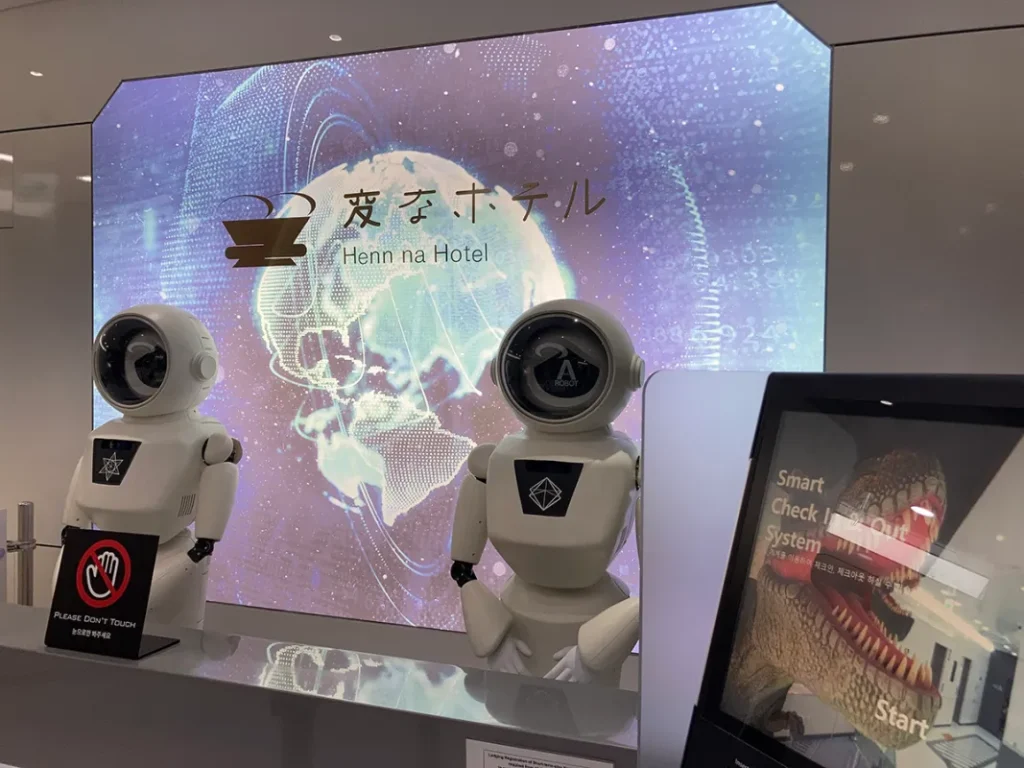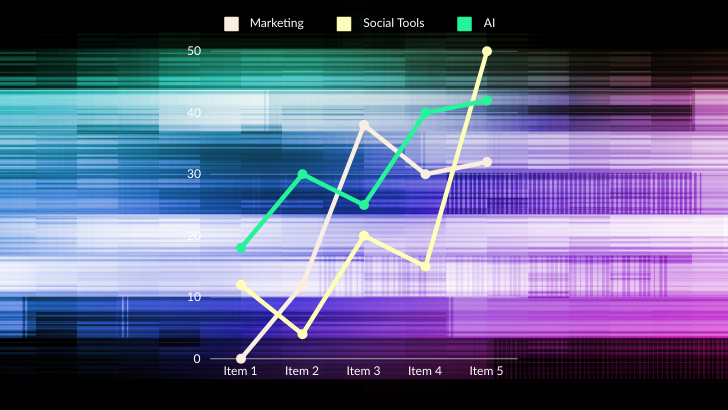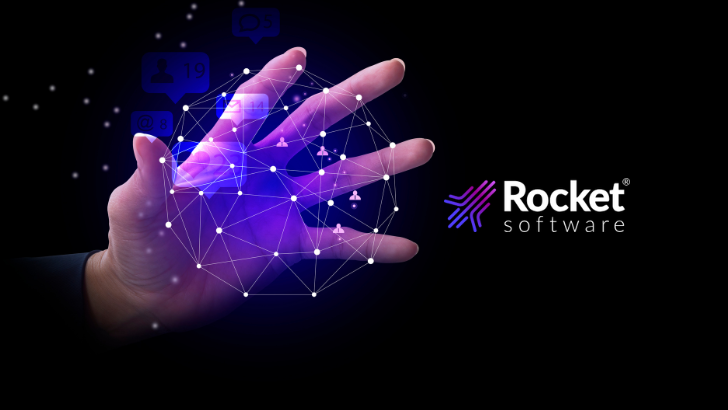This article was originally published in Experience Magazine, an award-winning online and print publication run out of Northeastern University. Experience tells stories about the intersection of technology and humanity — stories that look to the future; chronicle innovations in work, play, and human relationships; and examine solutions to global problems. Subscribe to Experience Magazine for more.
___
I met my first South Korean robots as I checked into the Henn na Hotel in Seoul at the end of a 21-hour journey from the U.S.: two plane flights and a bleary-eyed ride on the transit rail. To the left, two animatronic Tyrannosaurus rexes towered over the room, roaring with menace. Behind the front desk stood two gleaming white androids, with big round heads framing green digital eyes and thin green smiles. I headed for the androids.
The robot clerk on the right came alive to greet me — first in English, then in Korean, Japanese, and Chinese, in quick succession. “Welcome to the Henn na Hotel!” it said in a chirpy female voice. It was eerily humanoid yet inhuman, with hands that looked like white-fingered gloves and thin black mechanical joints for elbows. Its cartoony face was drawn for friendliness. Its slender arms occasionally swept outward in a welcoming gesture.
“Please select check-in on the right side of the screen,” it said, pointing to a touchscreen. Off to the side, one T. rex roared again, swinging its head from left to right. Two plastic lampposts stood below the T. rexes, each just a few inches tall, set up to make the dinosaurs look like Godzillas rampaging through a city.
These robots were the first, but not the last, that I met over a nine-day stay in South Korea this past summer — metal-and-plastic helpers in public places, offering relentlessly friendly service and the occasional curious diversion. I met a robot that delivered toiletries to guest rooms, stumbled upon restaurant-server robots that carried trays of food, and followed a docent robot around a museum for a guided tour.
South Korea has the highest “robot density” in the world, with 93 robots per 1,000 human workers in manufacturing, according to 2020 figures from the International Federation of Robotics. (The U.S. and most European countries have robot densities between 10 and 30 per 1,000 workers.) And the use of robots is increasing exponentially: In January 2022, the Korea Herald reported that an estimated 3,000 serving robots may currently be in use in South Korean restaurants, up from only 50 in 2019.
Why is South Korea such a robot haven? There are a few possible reasons. Through agencies such as the Korea Institute for Robot Industry Advancement, the government has invested $430 million since 2008 in robotics research and development. South Korea’s strong manufacturing industries, from cars to semiconductors, lend themselves to adoption of industrial robots. Competition and idea exchanges with neighboring Japan may be a factor: “A lot of the research in very human-looking robots is out of groups in Japan,” says Timothy Bickmore, a computer science professor at Northeastern University.
South Korean and Japanese consumers have long been early adopters of new technologies, notes Hanumant Singh, director of Northeastern’s Field Robotics Lab. “They have a bunch of the tech giants,” he notes: Samsung in South Korea, Sony and Panasonic in Japan. “They’re happy to take on the latest and the greatest thing.”
Cultural differences may also play a role. A 2021 paper in the Boston Hospitality Review by University of Hong Kong scholars Sungwoo Choi and Lisa C. Wan suggests that East Asians view robots more positively than Westerners, for reasons that include religious influence and the cultures’ dominant systems of thinking. “East Asians tend to describe robots as both highly competent and warm, while Westerners tend to describe them as competent but cold,” Choi and Wan write. South Koreans’ vigilant approach to pandemic precaution — which has left the country with one-sixth as many COVID-19 deaths per capita as the U.S., and one-third as many as Germany, according to statistics compiled by Johns Hopkins University — may have given service robots a big boost. After all, touchless service means one less human breathing indoors near you.
South Korea is a test lab for a world where we’ll interact with talking robots every day, relying on them as hosts, helpers, and maybe even friendly companions. Yet my visit made it clear that robots have a lot to learn before we reach a state of sci-fi harmony. The robots I met in Seoul and beyond were very good at some jobs, still learning at others, and, occasionally, laughably bad. But programmers and researchers worldwide are working on machines that could coexist with us more gracefully. The key, they’ve found, is matching robot design to human nature.
In 2015, Guinness World Records named the inaugural branch of the Henn na Hotel, in Nagasaki, Japan, as the world’s first robot-staffed hotel. Henn na is Japanese for “weird,” and that’s clearly the vibe that the chain’s Seoul hotel is going for, with its roaring T. rexes in the lobby. “Helpful” seemed slightly less important; the sleek white-and-black robot I met at the front desk proved unable to cope with my human error. The touchscreen in front of my android greeter allowed me to check in with a cellphone number, but my jet-lagged brain forgot to start with the country code. The computer didn’t recognize my number. The robot, now impassive, was no help.
Fortunately, there was a man behind the curtain: A human clerk emerged from an office behind the front desk to help guide me through the check-in. He asked if I wanted two keycards for my room. Good idea, I agreed. He escorted me to the elevator and bade me good night. Human service 1, robot service 0.
Much more impressive was Henn na’s delivery robot, which I summoned using a touchscreen in my room. I ordered extras of several room amenities: two face towels, two bath towels, a “vanity set” of cotton swabs, and a packet of green tea. Six minutes later, I heard two sharp knocks on the door, and then, a moment later, two more.
I opened the door, and there stood a three-foot-ten cylinder on wheels, white with black trim, with a white arm folded atop it. The arm ended in a sort of face, with two black eye-like structures set into it — sensors, I imagined. There was a cushioned black dot on its forehead — the door-knocker, presumably.
The robot turned 180 degrees, so that a touchscreen faced me instead of the arm. “Arrived at the guest’s room,” the screen read. (Perhaps the human who had loaded the delivery robot also told it I was a guest from an English-speaking country.)
“Your order has arrived,” the robot said aloud in a soothing female voice. “Touch the ‘open tray’ button and collect items in the tray.” I fished out my items and closed the tray. “Thank you. Returning to the base station,” the robot said as its screen showed a five-second countdown. “Leaving to the destination now,” it finally declared. Then it rolled off down the hallway.
I watched as the robot pivoted to dodge a trash bag someone had left beside a doorway. Then it reached the elevator and turned a corner. “Calling the elevator,” the robot announced to no one. “Caution: the robot arm is reaching for the button.” Around the corner, I could just see a flash of the white arm moving to press the down arrow.
Soon, the elevator door opened to reveal two human guests, who saw the waiting robot and laughed. The man stepped out and the robot moved toward the door, then stopped as it sensed the woman still inside. She stepped around the robot and laughed again. All clear, the robot rolled onto the elevator, and the doors closed behind it.
“If the robot is telling people to get out of the way politely, it doesn’t have to be as aware as a human being — just kind of a bimbly, polite robot.”
Emily Collins, a research scientist at the Institute of Experiential Robotics at Northeastern University
The delivery robot — built by Robotis, a Seoul-based manufacturer — is called the House Ant, after ants’ ability to carry heavy loads. Robotis has contracts to deploy House Ants in 20 South Korean hotels by the end of 2022; international exports may come later. (Robotis is also testing its Worker Ant, an autonomous outdoor courier and food delivery robot, on city sidewalks within about a mile of the company’s headquarters.)
The House Ant was designed with the deferential politeness that hotel guests expect of hospitality workers — and with a tacit acknowledgment that having robots roaming the hotel hallways is, at this point, an odd experience for everyone. “It is not easy for robots to coexist in a building or space made for humans,” says Will Son, a research engineer for Robotis. “People feel uncomfortable with the robot that rides the elevator.” So Robotis programmed the House Ant to act as predictably as possible: waiting for humans to get on or off before making its move and playing a message apologizing for any inconvenience.
Those elevator skills are key to the House Ant’s success, says Emily Collins, a research scientist at the Institute of Experiential Robotics at Northeastern University. She has co-written several papers on robot-elevator navigation, with titles such as “Please Press Floor B” and “Help! I Can’t Reach the Buttons,” which argue that successful robots build trust with friendly statements, clear explanations of their intentions, and demonstrations of competence. After watching my video of the couple exiting the elevator and giggling at the robot, Collins was impressed. “In this scenario, that robot’s doing a grand job,” she says. “It almost looks to them that that robot’s deliberately there just for them, which is kind of adorable.”
The Henn na’s front-desk-clerk robots had even more tools to potentially charm a human visitor. Collins, who speaks Japanese, noticed that the clerk gave me an open-hand gesture when it said “thank you” in Japanese, but not in its other three languages. “It’s made a gesture at that particular point because you would associate a desk clerk saying ‘thank you’ with a bow, which it can’t do.”
Those kinds of movements go a long way toward forging human-robot connections, says Bickmore, who studies robot hand gestures in his lab at Northeastern. “People use their hands a lot in face-to-face conversation,” he says. Bigger gestures, he’s found, lead people to assume the robot is communicating largeness or making a positive statement.
Bickmore’s lab has been studying how to make human-robot interactions more like human face-to-face conversation. He’s programmed a robot to play the role of a health coach in a kitchen, pointing out foods in a pantry and explaining their health benefits. When the robot points to food, he says, people are likely to take its advice, if the robot also explains what it’s doing.
But the Henn na’s front-desk robots only point to the touchscreen and don’t explain much. To me, their hand gestures seemed eerie. I wondered if this might be an example of the “uncanny valley,” a theory of human-robot interactions that suggests people like it when a robot is human-like, up to a point — but if it seems too human, its small discrepancies from human behavior repel them.
Collins suggests that the problem might lie, instead, in the limited capabilities of the robots themselves. After a first round of hype, the original Henn na in Nagasaki laid off some of its robots for poor performance. It axed humanoid and dog robot dancers that kept breaking down, a concierge robot that couldn’t answer basic tourism questions, and voice-activated room assistants in the shape of three-eyed dolls that would talk, it turned out, when a guest snored too loudly. Its velociraptor robot front-desk clerks, which wear bellhop hats and bowties and warmly intone “Welcome” while making predatory clawing motions, need human help to scan guests’ passports.
Even the humanoid robot helper in Seoul, Collins notes, didn’t get the job done for me.
“I suspect,” she says, “its functionless-ness is irritating you.”
It’s true: Exposed to robots in public, I quickly developed a Protestant-work-ethic attitude toward them. I wanted them to work hard and earn their keep. So it’s no wonder I liked the waiter-robots I encountered — first, in the narrow aisles of a dumpling restaurant near my hotel, and two days later, when a server robot rolled up to my table at a tofu restaurant in Imjingak, a park near the North Korean border filled with Korean War memorials.
Using a touchscreen at the table, my interpreter and I had ordered a beef and tofu stew. A few minutes later, the server robot arrived: a cylinder-shaped stack of three trays on wheels, with no part of it resembling a face. The top tray held banchan, the little appetizer dishes commonly served with Korean meals; the middle tray held empty soup bowls, a ladle, and drinks; the bottom tray carried a portable burner for keeping the soup warm.
The robot introduced itself in Korean, then switched to English. “The food you ordered has arrived,” it said, then awkwardly told us to serve ourselves: “Please drop the food. Thank you.”
Once the trays were unloaded, the robot turned and rolled back to the kitchen. Soon, a human waitress arrived with the main course, in a metal bowl filled high enough that human balance was the better bet to keep it from spilling.
The robot is called Servi, and it’s the product of a collaboration between California-based Bear Robotics and KT Corporation, a Korean telecom company that aims to evolve into a digital platform company. Servis are also starting to appear in some U.S. chain restaurants: Denny’s installed them in a few of its locations starting in 2021. Chili’s, which renamed the Servi “Rita the Robot,” deployed them in 10 restaurants in 2020 and 51 more in 2022 — about 5% of its roughly 1,300 U.S. locations.
When Chili’s announced the second round of Ritas, a company executive enthused to reporters that the robot could seat diners like a human host, bus tables, deliver up to 50 pounds of plates, and even sing “Happy Birthday.” Rather than displace waitstaff, the chain said, the Servis gave them more time to interact with customers. But in August 2022, Chili’s announced it wouldn’t add any more Ritas, saying they’d failed to deliver a clear return on investment.
Industries will face similar growing pains as they hire more robots for customer-facing jobs. Hospitality-trend scholars argue that robots can be programmed to speak more languages than most human workers, providing more efficient service to international guests. But robots may not always do the job better than humans, and customers may not appreciate their efforts at robot charm.
And any robot hiring spree will raise larger social issues — such as how many of these robots will displace human workers. Today, businesses adopting robots say the mechanical workers are helping them navigate a documented labor shortage. But a 2018 report from the accounting firm PwC predicted that 25% of U.S. jobs in hotels and food service will be automated by the early 2030s. If service robots take off in the coming years, it could change the dynamics of entire sectors of the labor market.
The hospitality workers’ union UNITE HERE, based in the U.S. and Canada, is already pushing back. Its contracts with hotels in several U.S. cities require 180 days’ notice before a new technology is introduced. The Culinary Workers’ Union, a UNITE HERE local in Las Vegas, negotiated a 2018 contract that requires employers to retrain any worker displaced by a robot.
Though hotel and restaurant robots will be highly visible to the public, the future universe of service robots will be much broader. The annual ACM/IEEE International Conference on Human-Robot Interaction, last held in person in Daegu, South Korea, in 2019, and held online since 2020, offers a preview of the many robots we may encounter soon: caregivers for dementia patients, robots teaching motor skills to kids with cerebral palsy, home companion robots that read to preschool kids, robot water-bottle-fillers in nursing homes, robo-baristas, and robot pets that snuggle like cats to relieve their humans’ anxiety.
South Korean and U.S. companies are collaborating to get a share of these future markets. In 2021, Hyundai, South Korea’s second-largest company, bought Boston Dynamics, makers of the Spot robot dog. Naver, the South Korean internet giant, uses robots to deliver parcels, serve coffee, and take notes during meetings at its Seoul headquarters. In August 2021, Domino’s Pizza and South Korea’s transportation ministry collaborated with a drone company to create an aerial pizza delivery pilot program.
In his lab at Northeastern, Bickmore has developed several health-counselor robots, including a genetic-counseling robot and a couples-therapy robot. “They’re more engaging, more persuasive, if they’re physical [rather] than just an animated character on a screen,” he says. The lab’s couples counseling robot, a purple-haired head named Julia that sits atop a table, turns to each person to ask a question, making it clear whom it’s addressing.
Bickmore predicts that service robots will catch on more slowly in North America than in South Korea. “In the U.S. we don’t have quite the same infatuation with robots that many Asian countries seem to,” he says, “so I think the uptake here will be gated primarily by how useful the robots are — not just the novelty factor.”
But given advances in AI-driven robotics, he says, “over the next eight years, I would expect most people will have at least one or two daily interactions with robots.”

As robots improve their people skills, we’ll be drawn to their charisma. Walking through the National Museum of Korea’s main concourse, I saw a four-foot-tall robot rolling across the marble-tiled floor. A boy and a girl, each shorter than the robot, tagged along, the boy marching beside the robot, the girl — just behind — touching its back affectionately.
The robot had faux-human blue eyes, displayed on a black video screen embedded in its oval head. A blue video screen was mounted in its chest. Its white plastic body tapered outward and downward, like a shiny robe. Identical robots stood along the museum’s concourse, each waiting for a human to approach.
When I neared one, it started speaking to me in Korean, its blue eyes blinking. I pressed the “EN” button for English on the robot’s video-chest display, and the screen and voice switched languages. “Warm-hearted friend, museum with you,” the onscreen message read. I assumed that the robot was offering to be my warm-hearted pal, but Collins suggested that it was acknowledging my biology. (Hello, flesh being — I am here to be your techno friend!).
I pressed the button for “QI Docent.” The screen showed me a map of the museum’s first floor, and I clicked on the museum’s exhibit on Korea’s Joseon Dynasty, founded in 1392.
“We will move to the Joseon Dynasty One room! Please follow me!” the robot said in a chipper yet metallic female voice. It blinked, executed a turn, and led me down the concourse. “Excuse me,” the robot said when encountering some humans in its way. “Could you please step aside so that I can pass through?” A girl, walking by, waved to the robot as it moved; so did a grown woman.
Just outside the gallery, the robot stopped, turned, and started narrating, its chest-screen showing me images of the royal furniture inside. As it spoke aloud about Korean kings, its eyes’ pupils dilated, then turned into hearts. “In human interaction, eyes play a strong role in regulating the flow of the conversation,” Bickmore later told me. “The blinking of eyes is to demonstrate some notion of aliveness, maybe to keep your engagement in it.”
Collins thought the museum robot’s apologetic deference to me and passersby revealed shrewd programming. “Technology fails quite frequently,” she said. “With human psychology, we are much more forgiving of polite incompetence than people who are competent but very rude. If the robot is telling people to get out of the way politely, it doesn’t have to be as aware as a human being — just kind of a bimbly, polite robot.”
At the next gallery, the robot turned cheeky, cracking jokes and making casual comments. “There are many books in Joseon Room Two. Does this give you a headache?” it asked, deadpan. The joke fell flat — I like books! — but by then, the robot’s other efforts at rapport had already charmed me.
“We have a long way to go yet,” Bickmore agrees, “to make this more like talking to a human tour guide.” But in the next five to 10 years, he predicts, robots will get better at understanding human speech and non-verbal communication. Researchers, he says, will investigate “speech and all of the other aspects of face-to-face conversation, including not only the robot’s hand gestures, but your hand gestures, your gaze cues, your facial displays, and how this plays a role in the conversation to make it more natural and fluid.”
So maybe by 2030, I’ll encounter another robot museum guide, in Asia or the U.S. — one that can truly talk with me and crack a truly funny joke. If I do, I’ll recall the National Museum of Korea robot’s awkward charms with nostalgia: the beginning of a breakthrough, a weird new type of friendship that, in 2022, was only starting.
“My commentary ends here,” the museum robot said. “Did you enjoy it?”
___
This article was originally published by Experience Magaine.
Erick Trickey is Experience’s deputy editor. He has written for Politico Magazine, The Washington Post, Boston magazine, and more.
Photos by Erick Trickey




